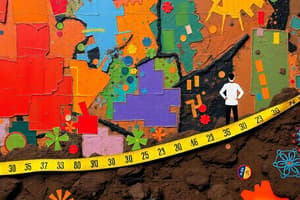Podcast
Questions and Answers
In forensic soil analysis, what is the main reason for identifying the different types of sand grains?
In forensic soil analysis, what is the main reason for identifying the different types of sand grains?
- To determine the moisture content of the soil sample.
- To easily identify the pH.
- To identify the exact age of the soil sample.
- To determine potential geographical locations of the soil's origin. (correct)
Which of the following components are considered abiotic factors in soil composition?
Which of the following components are considered abiotic factors in soil composition?
- Bacteria and decaying matter
- Decaying matter and air
- Water and minerals (correct)
- Living organisms and organic material
A soil sample is determined to be 70% sand, 20% silt, and 10% clay. According to the soil texture triangle, how would you classify this soil?
A soil sample is determined to be 70% sand, 20% silt, and 10% clay. According to the soil texture triangle, how would you classify this soil?
- Clay Loam
- Loamy Sand
- Silty Loam
- Sandy Loam (correct)
What can the analysis of soil textures and profiles reveal about a location?
What can the analysis of soil textures and profiles reveal about a location?
What is the significance of finding high levels of Calcium Carbonate in a soil sample during a forensic investigation?
What is the significance of finding high levels of Calcium Carbonate in a soil sample during a forensic investigation?
During the examination of soil from a gravesite, what does the mixing of subsoil and topsoil layers indicate?
During the examination of soil from a gravesite, what does the mixing of subsoil and topsoil layers indicate?
What is the purpose of documenting a crime scene before collecting soil evidence?
What is the purpose of documenting a crime scene before collecting soil evidence?
According to soil profiles, which horizon contains both humus and minerals and is also where plant roots are typically found?
According to soil profiles, which horizon contains both humus and minerals and is also where plant roots are typically found?
Why is it important to collect at least four tablespoons of soil from different locations at a crime scene?
Why is it important to collect at least four tablespoons of soil from different locations at a crime scene?
In the context of soil formation, what role does weathering play?
In the context of soil formation, what role does weathering play?
The presence of 'adipocere' in moist soils associated with gravesites is due to:
The presence of 'adipocere' in moist soils associated with gravesites is due to:
What does a cadaver decomposition island (CDI) indicate?
What does a cadaver decomposition island (CDI) indicate?
A soil sample predominantly composed of small, fine particles that retain a significant amount of water is likely classified as:
A soil sample predominantly composed of small, fine particles that retain a significant amount of water is likely classified as:
When examining sand grains under a microscope, what characteristic would suggest that the sand is mature?
When examining sand grains under a microscope, what characteristic would suggest that the sand is mature?
In soil analysis, what does the presence of skeletal remains or broken shells in a sand sample indicate?
In soil analysis, what does the presence of skeletal remains or broken shells in a sand sample indicate?
If a forensic investigation discovers soil with a high sand content near a crime scene, what initial conclusion can investigators draw?
If a forensic investigation discovers soil with a high sand content near a crime scene, what initial conclusion can investigators draw?
What evidence suggests that the suspect's car in Case #761 may have been near a coastal environment?
What evidence suggests that the suspect's car in Case #761 may have been near a coastal environment?
Why is understanding the soil's chemistry important in forensic science?
Why is understanding the soil's chemistry important in forensic science?
When analyzing soil samples, why is it essential to examine soil from objects at the crime scene?
When analyzing soil samples, why is it essential to examine soil from objects at the crime scene?
What feature is most characteristic of Continental sand?
What feature is most characteristic of Continental sand?
What is the most important reason that skeletal remains need to be located in sand to determine their origin?
What is the most important reason that skeletal remains need to be located in sand to determine their origin?
What type of sand is found near volcanoes?
What type of sand is found near volcanoes?
A forensic analyst examines an area and notices very little plant life. In a soil sample from the area, many nutrient rich materials are found. What might the analyst infer?
A forensic analyst examines an area and notices very little plant life. In a soil sample from the area, many nutrient rich materials are found. What might the analyst infer?
What is the main purpose of using UV light analysis in forensic soil examination?
What is the main purpose of using UV light analysis in forensic soil examination?
What are skeletons and broken shells?
What are skeletons and broken shells?
Flashcards
What is soil?
What is soil?
The top layer of the earth's crust, composed of biotic (living) and abiotic (nonliving) components.
What is soil texture?
What is soil texture?
The percentage of sand, silt, and clay that make up a soil.
What is silty loam?
What is silty loam?
A soil with 30% sand, 60% silt, and 10% clay.
What is silty clay loam?
What is silty clay loam?
Signup and view all the flashcards
What is erosion/weathering?
What is erosion/weathering?
Signup and view all the flashcards
What is sediment?
What is sediment?
Signup and view all the flashcards
What is humus?
What is humus?
Signup and view all the flashcards
What is topsoil?
What is topsoil?
Signup and view all the flashcards
What is soil layer E?
What is soil layer E?
Signup and view all the flashcards
What is subsoil?
What is subsoil?
Signup and view all the flashcards
What is broken rock Layer C?
What is broken rock Layer C?
Signup and view all the flashcards
What is solid rock Layer R?
What is solid rock Layer R?
Signup and view all the flashcards
Why are textures and profiles important?
Why are textures and profiles important?
Signup and view all the flashcards
How Does Sand Form?
How Does Sand Form?
Signup and view all the flashcards
Why Identify Sand?
Why Identify Sand?
Signup and view all the flashcards
What is Immature Sand?
What is Immature Sand?
Signup and view all the flashcards
What are fragments?
What are fragments?
Signup and view all the flashcards
What is Mature Sand?
What is Mature Sand?
Signup and view all the flashcards
What is Continental Sand?
What is Continental Sand?
Signup and view all the flashcards
What is Volcanic Sand?
What is Volcanic Sand?
Signup and view all the flashcards
What is Skeletal Sand?
What is Skeletal Sand?
Signup and view all the flashcards
What is Precipitate Sand?
What is Precipitate Sand?
Signup and view all the flashcards
What is Feldspar?
What is Feldspar?
Signup and view all the flashcards
What is Magnetite?
What is Magnetite?
Signup and view all the flashcards
What is Granite?
What is Granite?
Signup and view all the flashcards
Study Notes
Case #761 Soil Examination
- In a murder case, the suspect is in custody and refusing to speak
- A search warrant of the suspect's property found an empty house and a car covered in dirt
Analysis of Dirt From Car
- Composed of 60% sand, 30% silt, and 10% clay
- Analysis included microscope imagery of the sand
- High levels of Calcium Carbonate
What is Soil?
- The top layer of Earth's crust
- It contains living (biotic) and nonliving (abiotic) components
Abiotic Components
- Water & Air
- Minerals
- Includes disintegration from erosion and weathering
Biotic Components
- Bacteria
- Decay
- Includes nitrifying bacteria
Soil Texture
- There are 12 classifications based on the percentage of 3 different particles
Soil Particle Size and Characteristics
- Sand is coarse and water moves easily through it.
- Sand is typically found in deserts and beaches.
- Silt is medium and retains some water.
- Silt is commonly found in riverbeds.
- Clay is fine and retains water.
- It is found in various locations.
Soil Triangle and Texture
- Soil with 30% sand, 60% silt, and 10% clay is classified as silty loam
- Fertile soil, called "loam", contains mostly sand and silt with low clay content
- Soil that consists of 10% sand, 60% silt and 30% clay is silty clay loam
Soil Profiles
- Soil layers are arranged in horizons (O, A, E, B, C, R)
Horizons
- The O horizon is humus consisting of decaying organic matter.
- The A horizon is topsoil consisting of humus, minerals and plant roots.
- The E horizon consists of sand and silt, and water removes minerals from it.
- The B horizon is subsoil containing clay and mineral deposits.
- The C horizon is broken rock with no plants and little humus.
- The R horizon is solid rock with no plants and little humus.
Importance of Textures and Profiles
- Textures provide insight into locations
- Loams are found in gardens/woods
- Clay/silt come from non-surface layers
- Sands are unique
- Profiles reveal location and depth
Sand as a Soil Fingerprint
- Sand forms through the weathering of rocks/minerals, skeletal remains, and broken shells
- Sands can form in unique sizes from different sources
- Identifying sand is key to determining potential locations from the soil
Sand Maturity
- Immature sand has fragments, lots of clay, and found near rock
- Mature sand is smooth, with very little clay that located at beaches and dunes
Sand Types
- Continental sand is found at beaches and is made of quartz, mica and feldspar
- Volcanic sand is found near volcanoes and contains black basalt, green olivine and very little quartz
- Skeletal (biogenic) sand is made from remains of living organisms such as microorganisms, shells (CaCO3) and coral
- Precipitate sand is minerals deposited from evaporated water made of calcium carbonate that form oolites
Soil Chemistry
- Soil's ability to grow plants depends on the balance of essential nutrients and pH
- Calcium helps stems and leaves from drooping
- Nutrient deficiencies are impacted by pH levels
Effects of Bodies on Soil
- Bodies release toxic chemicals that kill plant life & nutrient rich fluids that change the soil
- Creates a cadaver decomposition island (CDI)
- In a CDI, there is an area of no growth and changing pH
Effects of Soil on Gravesites
- Digging mixes subsoil and topsoil, causing different colors
- Moist soils contribute to adipocere (grave wax) formation
- Wet/dry cycles can cause bones to expand and contract
- Acidic or alkaline soils slow down decomposition
- Low oxygen levels cause body to release gases that dogs can smell
Collecting Soil Evidence
- Photograph and document the crime scene
- Sketch the crime scene
- Collect at least 4 tablespoons of material from different locations
- Collect surface soil
- Any soil that looks different than the surrounding soil
- Collect soil from different levels
- Collect soil from objects at the crime scene
Analyzing Soil Evidence
- Microscope analysis can reveal locations based on shells, coral and plants
- Soil can reveal physical evidence such as bullets, sawdust, oils, glass, jewelry, keys and knives
- Soil can reveal biological evidence such as bones and teeth
Analyzing Soil Physical Properties
- Physical analysis of soil can be done by sorting and measuring size, location, and angle
- Determine % of sand, silt and clay contents
- Creating a soil profile
- Using a magnet to detect metals
- UV light analysis
Studying That Suits You
Use AI to generate personalized quizzes and flashcards to suit your learning preferences.




